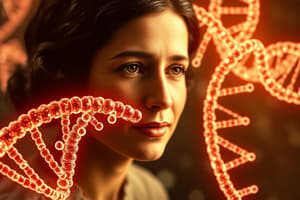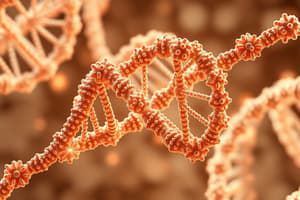Podcast
Questions and Answers
What specialized technique did Rosalind Franklin use to study the molecular structure of DNA?
What specialized technique did Rosalind Franklin use to study the molecular structure of DNA?
- Electron microscopy
- X-ray crystallography (correct)
- Nuclear magnetic resonance
- Mass spectrometry
In what year did Rosalind Franklin produce the first clear image of crystalline DNA?
In what year did Rosalind Franklin produce the first clear image of crystalline DNA?
- 1952 (correct)
- 1951
- 1953
- 1947
Which of the following statements accurately reflects Rosalind Franklin's contributions to science?
Which of the following statements accurately reflects Rosalind Franklin's contributions to science?
- Her work on DNA was largely overlooked compared to her male counterparts. (correct)
- She received significant recognition and awards for her work during her lifetime.
- She primarily focused on researching crop viruses throughout her career.
- She was the first scientist to decode the DNA structure.
Which institution did Rosalind Franklin join after her work in Paris?
Which institution did Rosalind Franklin join after her work in Paris?
What year did Rosalind Franklin complete her doctorate degree from the University of Cambridge?
What year did Rosalind Franklin complete her doctorate degree from the University of Cambridge?
What significant project did Maurice Wilkins contribute to during World War II?
What significant project did Maurice Wilkins contribute to during World War II?
What was the primary scientific method used by Wilkins to study DNA?
What was the primary scientific method used by Wilkins to study DNA?
What was a major outcome of Wilkins' partnership with Rosalind Franklin?
What was a major outcome of Wilkins' partnership with Rosalind Franklin?
Why was Rosalind Franklin not awarded a Nobel Prize for her contributions to DNA research?
Why was Rosalind Franklin not awarded a Nobel Prize for her contributions to DNA research?
What was a notable aspect of the financial support Wilkins received for his research?
What was a notable aspect of the financial support Wilkins received for his research?
What was the significant structural aspect of DNA revealed by Photograph 51?
What was the significant structural aspect of DNA revealed by Photograph 51?
What incorrect assumption about DNA's structure was challenged by Franklin's work?
What incorrect assumption about DNA's structure was challenged by Franklin's work?
Which of the following best describes the timing of Franklin's publication compared to her work with Crick and Watson?
Which of the following best describes the timing of Franklin's publication compared to her work with Crick and Watson?
What was a key focus of Franklin's research after moving to Birkbeck College?
What was a key focus of Franklin's research after moving to Birkbeck College?
What was a consequence of how Franklin's findings were shared with Crick and Watson?
What was a consequence of how Franklin's findings were shared with Crick and Watson?
Flashcards are hidden until you start studying
Study Notes
Rosalind Franklin
- British chemist whose pioneering work on the structure of DNA was pivotal to the field, but largely ignored during her lifetime.
- Graduated from the University of Cambridge in 1941 with a degree in physical chemistry.
- Researched coal and graphite, earning her doctorate from Cambridge in 1945.
- Specialized in X-ray crystallography after moving to Paris in 1947.
- This expertise proved invaluable in understanding DNA.
- Her work contributed significantly to major scientific mysteries during the 20th century, particularly in understanding the structure of DNA.
The DNA Race
- During the 1950s, scientists worldwide raced to discover the molecular structure of DNA, a chemical found in all living organisms that carries genetic information stored within deoxyribonucleic acid.
- James Watson and Francis Crick actively worked on this problem at Cambridge in 1951.
Franklin's Contributions
- Franklin began taking photographs of DNA strands at King's College, London in 1951.
- Her research was aided by physicists, biologists, and biochemists who pioneered biophysics approaches, utilizing physics to study biological molecules.
Key Events Timeline
- Born in London in 1920.
- Graduated from the University of Cambridge in 1941.
- Became a researcher for BCURA in 1942.
- Earned her doctorate from Cambridge in 1945.
- Moved to Paris and became an X-ray crystallographer in 1947.
- Began photographing DNA strands at King's College, London in 1951.
- Produced the first clear image of crystalline DNA, revealing its double helix structure in 1952.
- Moved to Birkbeck College, London, and led research into crop viruses in 1953.
"Science and everyday life cannot and should not be separated." - Rosalind Franklin, 1940
The Most Beautiful X-ray Photographs
- J.D. Bernal, 1958: Photograph 51 produced the first clear image of crystalline DNA's structure and is hailed as one of science's most important photographs.
- Key Findings from Photograph 51:
- DNA Structure: The X-ray image revealed DNA's structure to be a helix (spiral) formed of two strands, not three as previously believed.
- Backbone Positioning: Franklin proposed the DNA backbone lies on the molecule's exterior.
Franklin's Contributions and Recognition
- Early 1953: Franklin's work contributed significantly to understanding DNA's structure, but her findings were shared with Crick and Watson unknowingly, aiding them in confirming the double helical structure.
- Publication Delay: Franklin and her research team completed their DNA model and published their results in April 1953. Unfortunately, Franklin's contributions were not recognized.
Beyond DNA
- In 1953, Franklin moved to Birkbeck College, London, to study the crystalline structure of viruses.
- Using her crystallography skills, she proposed a new model for the tobacco mosaic virus (TMV)'s molecular structure.
- This model was subsequently proven correct.
Maurice Wilkins
- Born in New Zealand, but raised in the UK.
- Bio-physicist known for his X-ray studies that determined the structure of DNA.
- Awarded Nobel Prize.
- Education: Cambridge and Birmingham Universities.
- World War II: Worked on the Manhattan Project, developing the nuclear bomb, before joining King's College biophysics unit in 1946.
- Contribution to DNA research: Used X-ray imaging to study DNA, including an unhappy partnership with Rosalind Franklin. Shared Nobel Prize in Physiology or Medicine in 1962 with Francis Crick and James Watson for his work on the structure of DNA.
- Later Career: Became director of the biophysics unit in 1970, later emeritus professor of King's College.
Rosalind Franklin
- Untimely Death: Died in 1958, before receiving recognition for her work on the structure of DNA and other viruses.
- Contribution to DNA research: Studied the crystalline structure of other plant/human viruses and poliomyelitis. Her contribution and research were vital in determining the structure of DNA, but not awarded the Nobel Prize since it wasn't posthumous. However, she is credited with making huge advances in virology and for her significant contribution to one of the greatest scientific discoveries of all time.
- Funding: Wilkins received $13,000 grant to study the polio virus and bequeathed $4,000 to support a fellow scientist, Aaron Klug, in his work.
About the Instrument (X-Ray)
- Photograph 51 took 60 hours to produce using an X-ray.
Studying That Suits You
Use AI to generate personalized quizzes and flashcards to suit your learning preferences.





